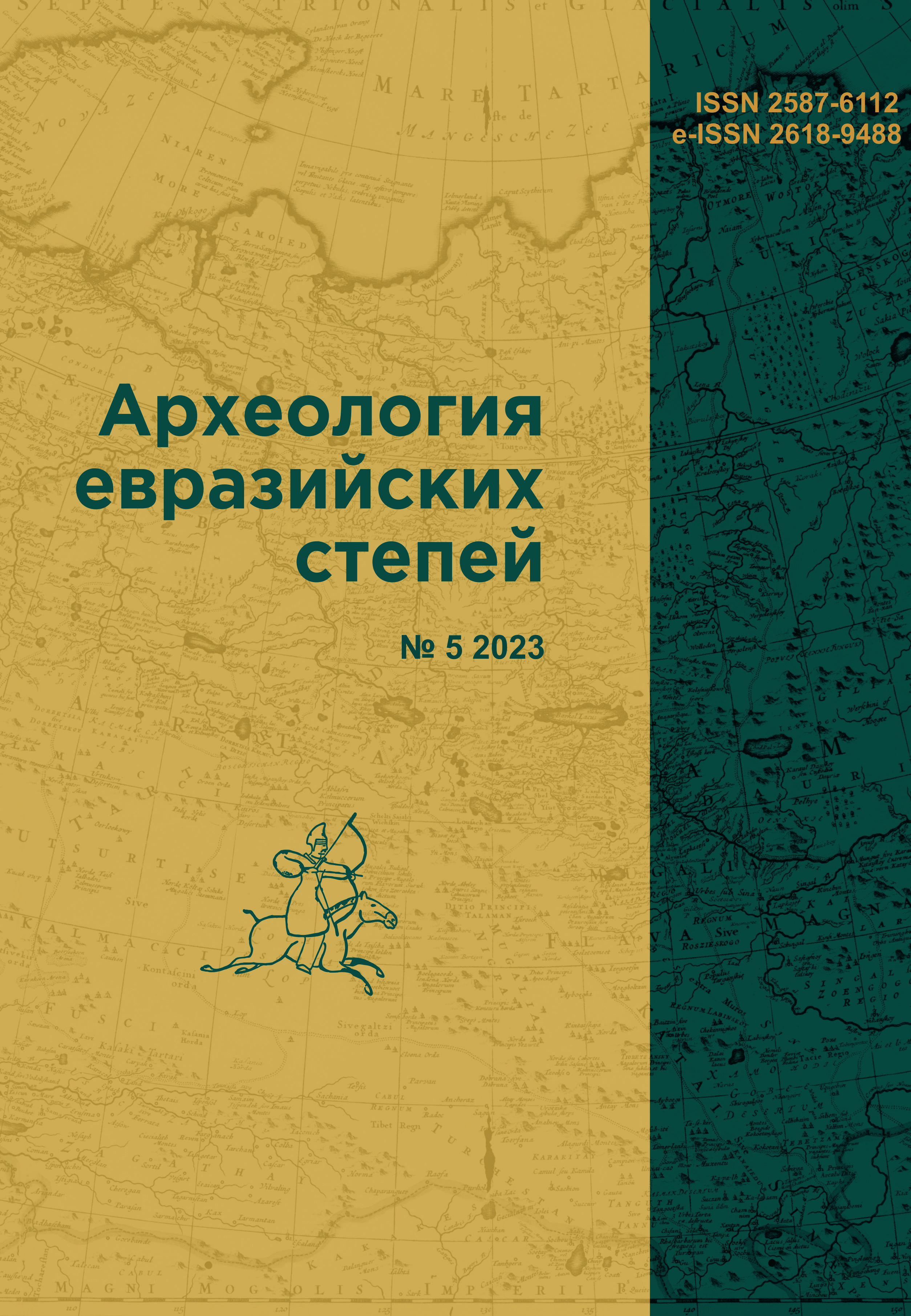Neolithic Burial Ground Bolshaya Umytia 100 in the North of Western Siberia: planography, chronology, stratigraphy
DOI:
https://doi.org/10.24852/2587-6112.2023.5.8.22Keywords:
archaeology, Western Siberia, Neolithic, burial rite, chronology, inhumation, cremationAbstract
The article presents the results of a study of the Neolithic burial ground Bolshaya Umytia 100, located in the upper part of the Konda River – the left tributary of the Irtysh River. The burial ground is characterized by biritual mortuary practice, i.e. inhumation and cremation in rectangular-shape burials, oriented NW–SE. The deceased were buried in a stretched position with their heads to the NW, cremated bones – in the center of the pits. The remains were covered with ochre. According to stratigraphy and carbon-14 dating, it was found that the most ancient were the burials of the first grave row. The recorded grave goods include renovated stone tools (adzes, chisel, point, arrowhead, plane tool), as well as unique artefacts – resin tube beads and an item made of a human skull. In contrast, the graves on the periphery of the burial ground with a spatial structure different from that of the central ochre graves, yielded no skeletal remains and grave goods. According to the few finds of Shoushma-type ceramics inside graves and on the ancient surface, the burial ground is dated back to the Middle Neolithic of the VI millennium BC at the Konda River. In terms of the scale and structure of the cemetery, the site is comparable to the large Meso-Neolithic burial grounds of the VIII–VI millennium BC in the northeast of Europe.
References
Besprozvanny, E. M., Pogodin A. A. 1998. In Kovaleva, V. T. (ed.). Voprosy arkheologii Urala (Issues of the Ural Archaeology) 23. Ekaterinburg: Ural State University, 48–62 (in Russian).
Besprozvanny, E. M., Starostina, E. E. 1986. In Khlobystin, L. P. (ed.). Problemy uralo-sibirskoy arkheologii (Issues of Ural-Siberian archaeology). Series: Voprosy arkheologii Urala (Issues of the Ural Archaeology) 23. Sverdlovsk: Ural State University, 33–38 (in Russian).
Gurina, N. N. 1956. Oleneostrovskiy mogil'nik (Oleneostrovsky Burial Ground). Series: Materialy i issledovaniia po arkheologii SSSR (Materials and Research in the USSR Archaeology) 47. Moscow: “Nauka” Publ. (in Russian).
Dubovtseva, E. N., Klementyeva, T. Yu. 2022. In Ural'skii istoricheskii vestnik (Ural Historical Bulletin) 2 (75), 139–148 (in Russian).
Klementyeva, T. Yu., Pogodin, A. A. 2017. In Trufanov, A. Ya. (ed.). Arkheologiya i istoriya Severo-Zapadnoy Sibiri (Archaeology and history of Northwest Siberia). Neftyugansk; Ekaterinburg: “Ural’skii rabochii” Publ., 20–49 (in Russian).
Klementyeva T. Yu., Pogodin, A. A. 2020. In Samarskii nauchnyi vestnik (Samara Scientific Bulletin) 30 (1), 131–141 (in Russian).
Klement'eva T. Yu., Pogodin, A. A. 2020. In Vestnik Novosibirskogo Gosudarstvennogo universiteta. Istoriia, filologiya (Bulletin of the Novosibirsk State University: History, Philology) 19 (7), 216–228
(in Russian).
Klementyeva, T. Yu., Pogodin, A. A., Dubovtseva E. N. 2020. In Povolzhskaya arkheologiya (Volga River Region Archaeology) 33 (3), 84–99 (in Russian).
Klementyeva, T. Yu., Trufanov, A. Ya. 2019. In Vestnik Permskogo universiteta. Seriia «Istoriia» (Bulletin of the Perm University. History Series) 44 (1), 20–33 (in Russian).
Kostyleva, E. L., Utkin, A. V. 2010. Neo-eneoliticheskie mogil'niki Verkhnego Povolzh'ya i Volgo-Okskogo mezhdurech'ya: planigraficheskie i khronologicheskie struktury (Neolithic -Eneolithic Burial Grounds on the Upper Volga and the Volga-Oka Interfluve: Planigraphic and Chronological Structures). Moscow: “TAUS” Publ. (in Russian).
Ol'khovsky, V. S. 1986. In Sovetskaia Arkheologiia (Soviet Archaeology) (1), 65–76 (in Russian).
Pogodin, A. A. 1994. In Man’kova, I. L. (ed.). Surgut, Sibir', Rossiya. (Surgut, Siberia, Russia). Ekaterinburg: Ural State University, 173–176 (in Russian).
Pogodin A. A., Trufanov, A. Ya. 2017. In Trufanov, A. Ya. (ed.). Arkheologiya i istoriya Severo-Zapadnoy Sibiri (Archaeology and history of Northwest Siberia). Neftyugansk; Ekaterinburg: “Ural’skii rabochii” Publ., 59–87 (in Russian).
Kosinskaya, L. L., Trufanov, A. Ya. (eds.). 2006. Poselenie Bystryy Kul'egan 66: pamyatnik epokhi neolita Surgutskogo Priob'ya (Bystry Kulyogan 66 settlement: Neolithic site of the Surgut Ob region). Ekaterinburg; Surgut: “Ural’skoye izd-vo” Publ.(in Russian).
Ahola, М. Е. 2015. In Thanatos. 4 (2). 23–40. Available at: URL: https://helda.helsinki.fi/handle/10138/310555 (accessed: 10.11.2022) (in English).
Zagorska, I. 2016. In Mesolithic burials – Rites, symbols and social organization of early postglacial communities. International Conference Halle (Saale), Germany, 18th – 21st September 2013 / Tagungen des Landesmuseums für Vorgeschichte. Band 13/1. Halle. 229–238. Available at: URL: https://www.academia.edu/37592786/Mesolithic_burials_Rites_symbols_and_social_organisation_of_early_postglacial_communities (accessed: 10.11.2022) (in English).

Downloads
Published
How to Cite
Issue
Section
License
Copyright (c) 2023 T.Yu. Klementyeva, A.A. Pogodin, A.Ya. Trufanov

This work is licensed under a Creative Commons Attribution-NonCommercial 4.0 International License.







